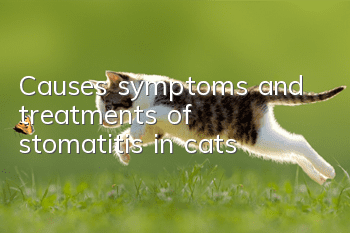Causes, symptoms and treatments of stomatitis in cats

Cat stomatitis is a relatively common disease in cats and an inflammation of the cat’s oral cavity. Feline stomatitis can be localized or diffuse. There are many causes of stomatitis in cats, and the editor will analyze them for you.
1. There are many causes: mechanical injuries, such as bone spurs, fish bone punctures, and burns.
2. Corrosion by chemicals.
3. Nutritional deficiencies, such as vitamin B deficiency.
4. Bacterial and viral infections, such as Fusiform spirochetes, Candida albicans, feline rhinotracheitis virus, and calicivirus.
5. Autoimmune diseases.
6. Dental disease and dental calculus can all cause this disease.
So what are the symptoms of cat stomatitis?
1. Due to different types and degrees of inflammation, the clinical manifestations of the disease vary.
2. Most cats suffer from loss of appetite or disappear completely. Especially when cats are eating, they often salivate a lot. Some cats shake their heads and whine while eating. This is a reaction to food stimulating pain points.
3. Oral examination, the mucosa is congested and red, the epithelium is peeled off or ulcerated, and there is an unpleasant putrid smell.
4. In more serious cases, sticky, brown, smelly secretions flow from the mouth, and the desire to drink increases, so oral examination is refused. In poor spirits. Loss of appetite or loss of appetite, increased desire, and clear and watery saliva at the mouth. Oral mucosa is congested, ulcerated or suppurated, with bad breath, difficulty chewing and pain.
How to treat stomatitis in cats?
1. Remove the causes of disease such as foreign bodies, tartar, and bad teeth. Improve feeding management and feed liquid or easily chewable food.
2. For catarrhal stomatitis and vesicular stomatitis, clean the mouth with 0.1% potassium permanganate solution and inject complex vitamin B and vitamin C at the same time.
3. For ulcerative stomatitis, you can use a silver nitrate rod or 5% silver nitrate solution to corrode the surface of the ulcer, and then apply compound iodine glycerin.
4. For fungal stomatitis, 2% gentian violet solution can be used for oral coating; 100,000 units of nystatin per kilogram of body weight can be taken orally, twice a day.
5. Antibiotic therapy, penicillin 50,000 units per kilogram of body weight, dexamethasone injection 0.5 mg per kilogram of body weight, mixed intramuscular injection, twice a day, for 3 to 5 days.
6. Cats with serious illness can be combined with systemic infusion therapy.
- Why do cats need to sharpen their claws?
- How to clean cat eye poop?
- How to clean a kitten that is too dirty to bathe
- What should I do if my female cat has a lump in her breast?
- Are Somali cats clingy?
- Why do cats curl up in balls when sleeping?
- Ragdoll Cat Personality Cat fairies don’t come for nothing!
- What is the best thing for a cat to eat after giving birth? What is the best thing for a female cat to eat after giving birth?
- What to do if a Canadian hairless cat has a difficult birth
- What should cats eat after giving birth?



